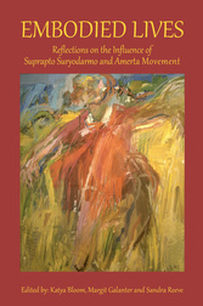Suprapto Suryodarmo (Prapto) (1945-2019) Prapto's Amerta Movement practice was developed at Padepokan Lemah Putih (Prapto’s interdisciplinary arts institution, located near Solo, Central Java) and also throughout the world where he travelled and taught, in conversation with participants from many different countries. In 1970, Prapto started “to practise movement with the approach of exploring like a child…” He practised “in many conditions of time and space, in nature, temples exploring the qualities of freedom and limitation”. He perceived the world through movement rather than from stasis, or, as he initially described it, “from the Buddha walking, rather than from the Buddha sitting”. Alongside Buddhist practice and observing the movement of children, his practice was influenced by studying the elements and movement in nature, the practice of Sumarah (a traditional Javanese meditation practice of ‘letting go’ or surrender) and, through his parents’ influence, Javanese mysticism. In his seminal performance Wayang Buddha (Buddha’s Shadow Puppet), first performed in 1975, Prapto demonstrated his innovative combining of traditional and contemporary forms by moving as a self-articulating shadow puppet, as puppet and puppeteer in one. He embodied the central Buddhist precept that the only constant in life is change, as exemplified through movement: he was moving, the sound was moving, the light was moving, the screen was moving and the members of the audience were moving. This performance could be seen as one of the early examples of developing contemporary performance without losing the roots of Javanese traditional culture. In 1982 Prapto travelled to Europe for the first time with the Sardono Dance Company for the Milan Siladek International Pantomime Festival in Cologne, germany. As a result of contacts made during that trip and during a subsequent trip to Switzerland in 1983, three Westerners travelled out to Solo to work with him for two months in March 1984. Thus began an avid exchange of movement practices, of attitudes and approaches to life, an in-depth process of meeting between East and West that lasted for over three years. Some of Prapto’s Western colleagues practised Tai chi and/or had studied with Anna Halprin, amongst other somatic movement traditions. Among a variety of cultural backgrounds, the main language, passion and tool for research was movement itself. Over time each person, including Prapto, developed their own particular approach to movement in dialogue with their own traditions and by “cooking” their own particular approach as they shared experiences with their colleagues. Prapto called the emerging work Amerta Movement, meaning the ‘nectar of life’ movement. More formal movement workshops in Java began in the Spring of 1986 and gradually Prapto established the course programme at the Padepokan Lemah Putih. His stated intention was “lessening the sense of identification through the practice of movement arts”, which explicitly informed the cycle of his movement workshop programme thereafter, as well as the design of his garden school and his performance work. In 2010 the name of Prapto’s work evolved and became Joged Amerta. This change was due to his feeling that his moving being had also become a dancing being “moving dancing, dancing moving” and he wanted the name of his work to reflect that development. Joged is a common word for dance in Indonesia and also carries a sense of social culture, ranging from children who dance for fun right through to the dances in high society. For example, joged exists in the palace culture in Yogyakarta up until this day. Latterly Prapto used the term Joged Amerta for his own work. This released the term Amerta Movement as a more generic term for the garden of work inspired and influenced by his practice. Unlike similar practices, Amerta was never meant to be passed down to students in the more formal, teacher-student style of pedagogical training, which he referred to as a ‘pyramid approach’. Although there was a series of courses that comprises the framework of Joged Amerta, and a logical progression from one course to another, there was no formal training to become a teacher. Instead of teachers, Prapto created over time a list of around 90 ‘dialoguers’ who had his permission to share practice within the tradition of Amerta Movement. Prapto encouraged these dialoguers to offer practice from the attitude of ‘gardener’ rather than from the attitude of ‘teacher’. A gardener is creative and tends to the needs of the soil and habitat as well as to each particular organism. Each plant has different requirements to grow and blossom. A gardener/teacher is trained to “open the atmosphere first in space and time” and then “to see the condition, the habit of body, the character of person, like nutrition of growing” with the intention of supporting the growth and ‘blossoming’ of the mover. So the gardener is invited to see from the mover’s potential (“like nutrition of growing”) rather than from the mover’s problems or difficulties. This is coherent with a view of no fixed sense of self, a view based in the constancy of change. In practice it demands a dynamic, creative, responsive approach and cultivates an atmosphere and an attitude of loving-kindness. For a series of recordings of Prapto talking, see Cosmos as the Garden. |
For a series of recordings of Prapto talking, see Cosmos as the Garden.
Related titles: Attending to Movement Body and Awareness Body and Performance Embodied Lives Nine Ways of Seeing a Body Suomenlinna // Gropius The Roots of Amerta Movement All Movement & Somatics titles |

